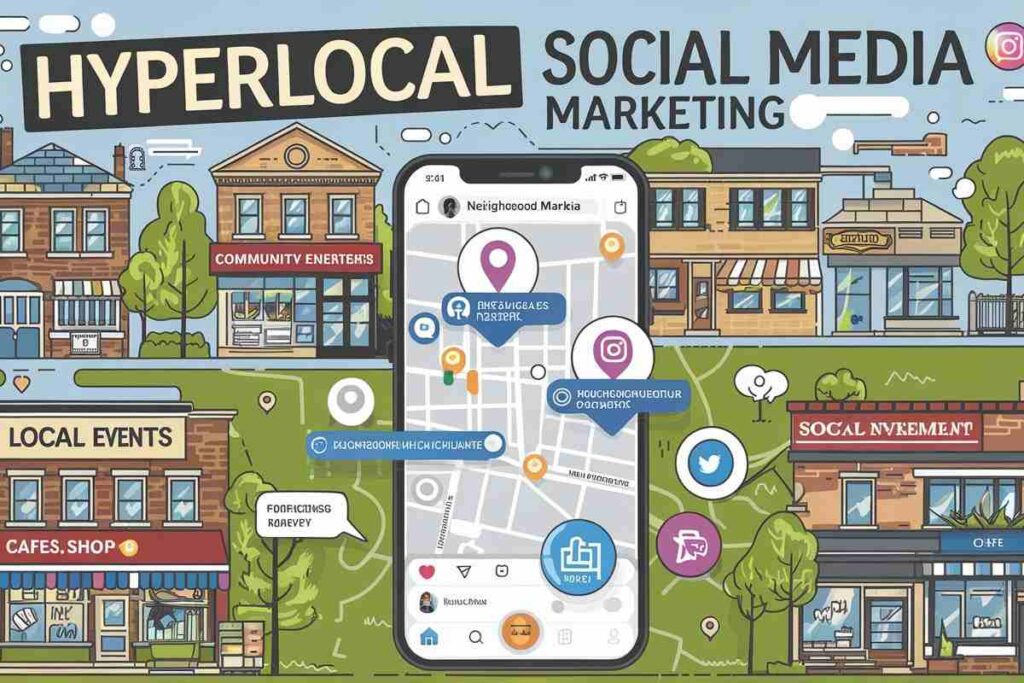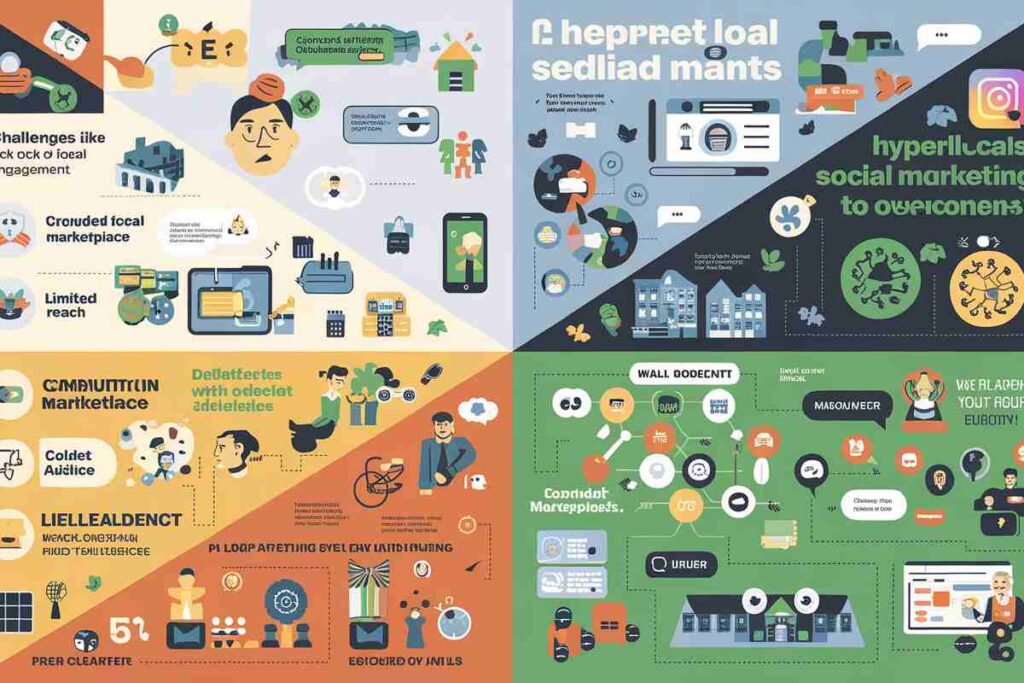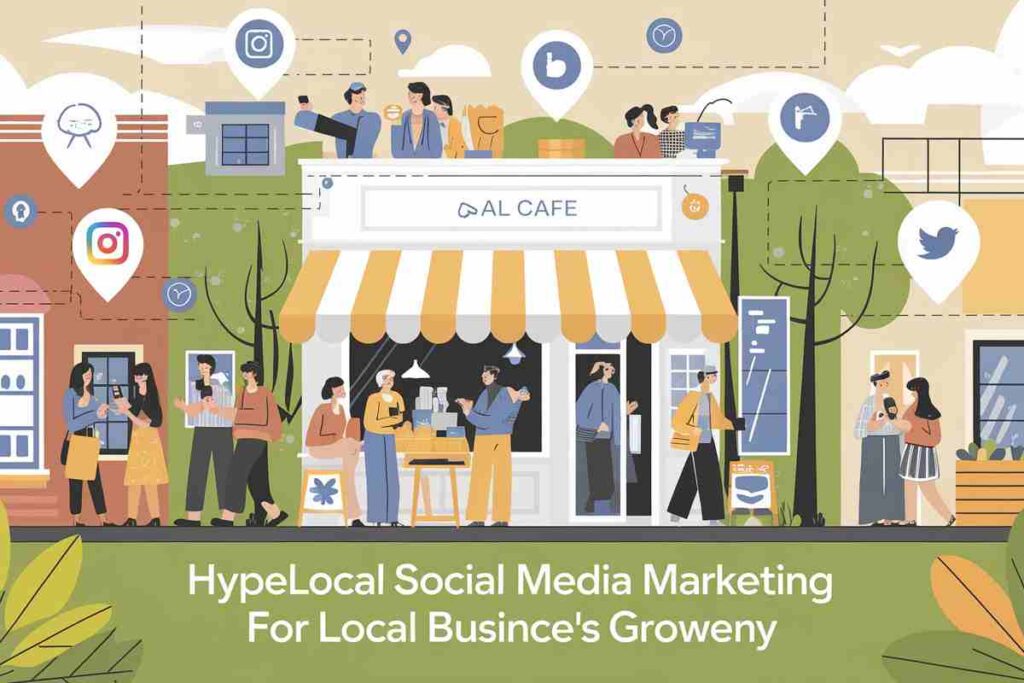Hyperlocal social media marketing is a digital marketing strategy that focuses on reaching audiences in a highly specific geographic area, such as a neighborhood, city block, or small community.
Unlike traditional marketing, which aims for a broader audience, hyperlocal strategies are designed to engage people based on their proximity to a business or event.
This approach is particularly effective for small businesses, brick-and-mortar stores, and local service providers looking to build strong relationships with their immediate communities.
The Importance of a Hyperlocal Social Media Marketing Strategy

A well-planned hyperlocal social media marketing strategy allows businesses to create highly relevant content that resonates with local audiences. By leveraging localized messaging, businesses can:
- Increase engagement with nearby customers
- Improve brand recognition in the local market
- Drive foot traffic to physical locations
- Establish strong community connections
- Enhance credibility and trust within a specific area
Lack of Data-Driven Insights – Added Statistics
Hyperlocal marketing isn’t just a trend—it delivers measurable results. Studies show that 72% of consumers who perform a local search visit a store within five miles, and 78% of location-based mobile searches result in an offline purchase.
These statistics highlight the impact of hyperlocal strategies in driving real-world business outcomes. Businesses that integrate geotargeted ads, location-based promotions, and neighborhood-focused content often experience 20-30% higher engagement rates than those using broad, untargeted campaigns.
Benefits of Hyperlocal Social Media Marketing
Hyperlocal social media marketing offers numerous advantages that can significantly enhance a local business’s success.
Building Strong Community Connections
- By promoting local events, supporting nearby causes, and highlighting community landmarks, businesses foster trust and connection within the community.
For instance, a café might post about a neighborhood farmers’ market or team up with nearby artists for an event. These gestures create loyalty and a positive image that resonates with local audiences.
Enhanced Customer Engagement
- Hyperlocal marketing allows businesses to engage with customers on a personal level, driving higher interaction and brand loyalty. Customers who feel personally connected to a business are more likely to engage with its posts and recommend it to friends and family.
Improved Conversion Rates
- Focusing on a specific area allows businesses to reach an audience that’s already interested in or familiar with their product or service. As a result, local ads and content are more likely to convert nearby leads into paying customers, enhancing ROI.
Cost-Effectiveness
- Hyperlocal social media marketing minimizes wasted ad spend by targeting only those who are geographically close to the business, making it a budget-friendly option for small and local businesses. Using tools like Facebook’s geotargeted ads or Instagram location tags, businesses can optimize ad budgets for maximum reach in the target area.
Effective Hyperlocal Social Media Marketing Strategies

To leverage hyperlocal social media marketing, businesses should implement these key strategies:
Audience Identification
- Understanding local customers’ interests, needs, and behaviors is crucial for effective hyperlocal marketing. For example, a fitness center might target health-conscious individuals in a particular zip code and share content about nearby jogging routes or outdoor events.
Local Market Analysis
- Analyze competitors, local market trends, and potential opportunities. Identify any gaps that your business can fill within the community. For instance, if no one in your area is offering weekend workshops, this could be an opportunity for a bakery or craft store to provide classes and draw a new crowd.
Tailored Content Creation
- Create content that appeals to the local audience by mentioning local landmarks, using location-based hashtags, or sharing neighborhood news. For example, using hashtags like #AustinEats if you’re a restaurant in Austin or #DowntownMiami if you’re a boutique in Miami helps increase visibility among local customers.
Effective Platform Selection
- Choose platforms that your target audience actively uses. Facebook and Instagram are popular choices for hyperlocal marketing, but Nextdoor and Twitter also offer local engagement options. A B2B business might benefit from LinkedIn, especially if targeting professionals in the area.
Engagement and Responsiveness
- Actively interact with followers by responding to comments, answering questions, and sharing user-generated content. If someone tags your business in a post or leaves a review, acknowledge it publicly. Building relationships is vital for creating a loyal local customer base.
Consistent Posting and Timing
- Post regularly to stay relevant and maintain visibility. Track and analyze the best times to post by studying when your audience is most active. Consistent, timely updates can help your business stay top-of-mind for local customers.
Expanded Future of Hyperlocal Social Media – Added Trends
As digital marketing evolves, hyperlocal strategies are set to become even more refined with AI-powered targeting and Augmented Reality (AR).
- AI & Predictive Analytics: Platforms like Google and Meta now use AI to optimize hyperlocal ad targeting, ensuring businesses reach people most likely to convert based on past behavior and real-time location data.
- Augmented Reality (AR): Brands are using AR to provide immersive, location-based experiences—like virtual store previews or AR-driven local scavenger hunts—to engage customers in a more interactive way.
- Voice Search & Local SEO: With the rise of voice assistants like Siri and Alexa, “near me” searches have increased by 500% in recent years. Businesses must optimize for local SEO keywords to appear in voice search results.
By staying ahead of these trends, businesses can future-proof their hyperlocal marketing strategies and ensure continued success in an increasingly localized digital landscape.
Hyperlocal Social Media Marketing Examples
Let’s look at a few practical examples to understand how businesses use hyperlocal strategies effectively.
- Example 1: Restaurant Promotions
A restaurant in Brooklyn uses Instagram to share daily specials, tagging their location and using hashtags like #BrooklynEats. They also engage with local food bloggers, inviting them for tasting events. This strategy brings in customers from the neighborhood who see these posts and reviews. - Example 2: Fitness Studio
A fitness studio in Denver creates Instagram Stories showcasing class schedules and highlighting participants in classes using geotags and local hashtags like #DenverFitness. They also use location-targeted ads for promotions, which are shown only to users within a 5-mile radius of the studio. - Example 3: Local Bookstore
A bookstore in Portland uses Facebook to announce in-store events, like book signings and local author readings. By collaborating with local authors and tagging them, they build a community of book lovers in their area.
These examples illustrate how using hyperlocal social media marketing can drive local traffic, enhance engagement, and create a strong community presence.
Popular Platforms for Hyperlocal Marketing
Different platforms provide unique features that work well for hyperlocal marketing efforts. Here’s how each platform can be used effectively:
- Facebook: With tools like Facebook Local and Facebook Events, businesses can promote events, sales, and community initiatives to local users. Facebook Groups also allow businesses to engage directly with community members.
- Instagram: By using location tags and local hashtags, Instagram helps businesses reach users nearby. Instagram Stories and Reels provide visual ways to showcase products or events in the local area.
- Nextdoor: This neighborhood-focused app allows businesses to engage directly with local customers. Posting updates, responding to recommendations, and participating in community discussions can increase visibility.
- Twitter: With its real-time engagement, Twitter is useful for sharing updates on events or promotions. Businesses can use advanced search filters to find conversations around specific locations or local topics.
What Are the Four Zones of Social Media Marketing?

Social media marketing can be divided into four key zones:
Customer Engagement and Support: Responding to inquiries, feedback, and comments to build trust and loyalty.
Community Building: Establishing a strong online presence and engaging with local followers.
Content Creation: Developing high-quality, localized content that resonates with the target audience.
Advertising and Promotion: Running geo-targeted ads to reach customers within a specific area.
Conclusion
Hyperlocal social media marketing is a powerful strategy for businesses looking to connect with their immediate community and drive local engagement.
By focusing on geo-targeted content, community involvement, influencer partnerships, and localized promotions, businesses can enhance their brand visibility, credibility, and customer loyalty.
Whether through social media ads, user-generated content, or collaborations with local influencers, hyperlocal marketing allows businesses to reach the right audience at the right time, ultimately leading to increased foot traffic and sales.
FAQs
What is Hyperlocal Social Media Marketing?
It is a marketing strategy that targets a specific geographic area, engaging local audiences through social media.
Why is Hyperlocal Marketing Important?
It helps businesses build strong community connections, increase brand recognition, and drive local foot traffic.
How Can Businesses Use Hyperlocal Marketing?
Businesses can use geo-targeted content, local events, influencer collaborations, and location-based ads.
What Platforms Are Best for Hyperlocal Marketing?
Facebook, Instagram, Nextdoor, and Google My Business are ideal for reaching local audiences.
How Do Geo-Targeted Ads Work?
They use location data to show ads to users within a specific radius of a business or event.
What Role Do Influencers Play in Hyperlocal Marketing?
Local influencers help promote businesses to a highly engaged audience within their community.
How Can Businesses Measure Hyperlocal Marketing Success?
Metrics like engagement, store visits, local followers, and sales conversions indicate success.
Is Hyperlocal Marketing Suitable for Online Businesses?
Yes, online businesses can use it to target specific regions with localized ads and promotions.
What is Hyperlocal Social Media Marketing, and Why is it Important?
Hyperlocal social media marketing targets specific local areas to engage nearby customers, boost visibility, and drive foot traffic. It improves brand trust, builds community connections, and enhances local sales.
How Do You Create a Successful Hyperlocal Social Media Strategy?
Identify your audience, use geotags and local hashtags, collaborate with influencers, and run geo-targeted ads. Engage with user-generated content and respond to local reviews to build trust.
What Social Media Platforms Are Best for Hyperlocal Marketing?
Facebook, Instagram, and Google My Business work best for location-based visibility, while Nextdoor and Twitter help with local engagement. TikTok is great for viral local trends.
How Can Small Businesses Benefit from Hyperlocal Social Media?
Small businesses gain local exposure, increase sales, and build trust by running targeted ads, sharing community-focused content, and partnering with local influencers




